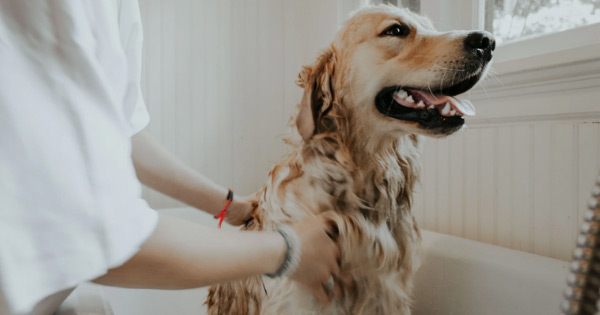
Fleas are the most common external parasite that affects dogs and cats. They can make your pets very uncomfortable and trigger them to repeatedly bite and scratch their skin. Fleas can also cause certain illnesses, which is why it’s important to treat your pets and get rid of those little bloodsuckers. This is why flea treatment and management is important.
How to Identify Fleas
To effectively rid your pet of fleas, you first need to identify them. Fleas are small, wingless, and about ⅛” long (1 to 3mm). Their bodies are shiny, brownish-black in color, and covered with microscopic hair. They’re laterally compressed with backward-pointing bristles to allow for easy movement through animal fur. This also makes them much more difficult to remove by grooming.
Fleas are wingless, but they are capable of jumping long distances. Flea larvae are less than ¼” long, dirty white in color, and legless. You’re likely to find larvae in pet bedding, carpets, or behind furniture.
Signs That Your Pet Has Fleas
The best way to determine the presence of fleas is to meticulously comb through your pet’s fur with a fine-toothed flea comb. The comb can confirm flea infestation if it picks up adult fleas. Adult fleas are most commonly found on the abdomen, head, and at the base of the tail. When you part your pet’s hair, you may also find deposits of “flea dirt” – small dark brown or black flecks that look like pepper.
Flea dirt is feces consisting mostly of digested blood. Even if adult fleas are not found, flea dirt can demonstrate the presence of fleas. This dirt will dissolve and leave red-brown blood marks when placed on a damp cloth. If your pet is licking, chewing, biting, or scratching more than usual, fleas are a likely culprit. Once you suspect fleas, you should visit your vet to confirm their presence.
Problems Associated With Fleas
Flea bites cause local skin irritation that may cause your pet serious discomfort. Flea bites are typically characterized by small, red spots surrounded by a red halo. Some animals can also be allergic to the saliva of fleas. This can result in excessive scratching and hair loss which can lead to a bacterial skin infection. It can take just one bite to initiate an allergic reaction and cause Flea Allergy Dermatitis (FAD).
Fleas can consume up to 15 times their body weight in blood. Too many bites can cause anemia and low red blood cell count, especially in small or young cats and dogs. Additionally, there is the risk of tapeworms if your pet ingests fleas that contain a cyst of the tapeworm.
Flea Treatment and Management
Protecting your home and furry companions against fleas requires pet and house treatments plus strict sanitization. Pet flea treatments include:
- Spot on formula
- Systemic oral treatments
- Flea collars
- Shampoo for flea prevention
- Flea sprays
- Flea tablets
It’s worth noting that you should never use household flea treatments on your pet. Additionally, you should use the correct flea treatment for your pet. For example, flea treatments meant for dogs should not be used on cats.
Even after all fleas have been treated and removed from your pet, it’s also important to treat your home and surroundings. After feeding, adult females can lay up to 40 eggs each day and up to 2,000 in their lifetime. Because the eggs are not attached to the animal, they’ll quickly drop off into furniture, carpeting, cat boxes, crates, kennels, carpets, and other places your pet hangs around. Eggs will then hatch and the larvae will grow into fleas that jump back onto your pet.
To sanitize your home, clean everything thoroughly and use a strong vacuum to remove flea eggs, larvae, pupae, and adult fleas. You should especially focus on places your pet likes to spend time. Vacuuming pulls fleas out of their hiding places and pushes pre-adult ones out of their cocoons. Empty the canister outside and wash it with hot, soapy water after you empty it. Also, make sure you frequently wash and dry pet bedding.
Several insecticides have insect growth regulators that help control fleas indoors. Use an aerosol or hand sprayer to apply insecticides directly to infested areas. Before you use any insecticides, however, check with your veterinarian. You may also need to apply treatments to prevent re-infection. This would target shaded and protected areas such as crawl spaces, sheltered animal enclosures, and vegetated areas adjacent to buildings. Treatments and sanitizations should be done on a regular basis.
Contact Naples Coastal Vet Animal Hospital
Contact Naples Coastal Animal Hospital for any questions about the safety and efficiency of flea control products or questions about flea treatment and management. Our professional team can help by recommending treatment and products to suit your pet’s needs. The happiness and health of your pet is our primary goal.
